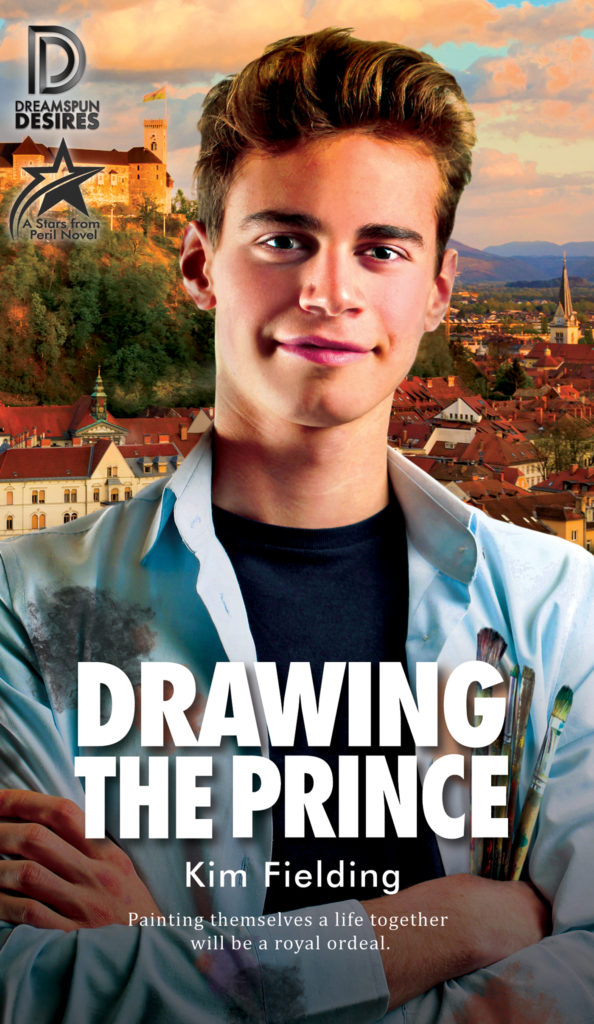Hi! I’m Kim Fielding, here to celebrate the release of Drawing the Prince.
As the title suggests, one of the heroes of this story is an artist. (I’ll give you three guesses what the other guy is.) Cal Walters graduated art school only a year ago, but thanks to his talent and connections, he’s already experiencing considerable fame.
Honestly, I’m a little envious of Cal because my ability to create visual art is seriously limited. I can picture things in my head—I think I have a fairly good eye and my visual sense isn’t bad—but I can’t create them. Not in any medium. I can barely draw stick figures. I can labor all day over digital manipulations and they’ll still suck. I took a ceramics classes for several semesters, and although I had great fun, everything I made is ugly (I like my ugly pots and sculptures anyway). I suppose if I took lessons from a very patient teacher, my artistic skills might improve a little, but they’d never be good.
Even if I can’t make art, I can appreciate it. I enjoy visiting museums, for instance. I’ve been fortunate enough to go to some amazing ones over the years. This summer I got to spend a few hours at the Rijksmuseum in Amsterdam, admiring Dutch painters such as Rembrandt, Vermeer, and van Gogh. A few weeks later I went to see the very different collection at the Museum of Contemporary Art in Los Angeles.
Like my appreciation for literature, my appreciation of art is diverse. I love looking at reproductions of prehistoric cave paintings, and I’ve considered myself fortunate to see ancient American petroglyphs. But I’m just as happy staring at a sculpture by Michelangelo, a painting by Picasso, or a photo by Dorothea Lange. Yes, I have some favorite genres—and a few that I’m generally content to skip, like all those gallery rooms full of people in ruffled collars. But I can’t say there are any art genres I genuinely dislike.
Art is interactive. It tells us something about the time and place where it was made, as well as about the person who made it. But it also tells us something about ourselves. For example, my emotional reaction when regarding Hokusai’s The Great Wave may be entirely different from yours, yet both of our reactions are equally valid.
Art can tell a story without saying a word. Consider Degas’s The Absinthe Drinker, where a man and a woman sit silently with their drinks. Who is that woman, and why does she look so melancholy? Who is the man beside her? They’re not real, of course—just smears of paint put on canvas nearly 150 years ago, yet we see them as people with histories and feelings. Even abstract art like Rothko’s squares and Pollock’s drips and squiggles connect with us, much like stories and music do.
Art can be highbrow, placed with great care in fancy museums or places of worship, sold at auctions for millions of dollars. Or it can be literally pedestrian, such as the long spray-paint-adorned walls along Ghent’s Graffiti Street.
Art sparks interactions. We can join in admiring it, we can discuss its meaning and impact, and we can even get into vigorous disagreements about it. One famous example of this involved the works of Robert Mapplethorpe: in 1990 a Cincinnati museum exhibiting his photographs was criminally tried for obscenity. The jury found them not guilty.
Art is political, making statements and advancing movements. In many cases, art is the face of social change.
And finally, art brings us together. In Drawing the Prince, it’s Cal’s paintings and sketches that first catch Teo’s interest and provide a vehicle for them to get to know each other. Yes, art can lead to love.
What place do the visual arts have in your life?
Blurb:
A Stars from Peril Novel
Painting themselves a life together will be a royal ordeal.
Small-town boy Cal Walters doesn’t know whether he owes his phenomenal success as an artist to talent or to his connections to famous people. Doubt leaves him secluded—until a lost bet lands him on yet another blind date. But this one is different.
To Teofilo Vabriga-Kastav, playboy prince of the tiny nation of Porvunia and passionate art lover, Cal’s paintings are as intriguing as Cal himself. When Teo invites Cal to his country for an art competition, a whirlwind romance sweeps them up. But it can’t last—loyalties and obligations bind them to lives that are worlds apart.
Cal and Teo might’ve found their perfect complements in each other, but to hold on to their happiness, they’ll have to get creative.
Buy link:
Kim Fielding is the bestselling, award-winning author of numerous m/m romance novels, novellas, and short stories. Like Kim herself, her work is eclectic, spanning genres such as contemporary, fantasy, paranormal, and historical. Her stories are set in alternate worlds, in 15th century Bosnia, in modern-day Oregon. Her heroes are hipster architect werewolves, housekeepers, maimed giants, and conflicted graduate students. They’re usually flawed, they often encounter terrible obstacles, but they always find love.
Having migrated back and forth across the western two-thirds of the United States, Kim calls California home. She lives there with her family and her day job as a university professor, but escapes as often as possible via car, train, plane, or boat. This may explain why her characters often seem to be in transit as well. She dreams of traveling and writing full-time.
Follow Kim:
Website: http://www.kfieldingwrites.com/
Facebook: http://facebook.com/KFieldingWrites
Instagram: @KFieldingWrites
Twitter: @KFieldingWrites
Email: Kim@KFieldingWrites.com
Newsletter: http://eepurl.com/bau3S9



